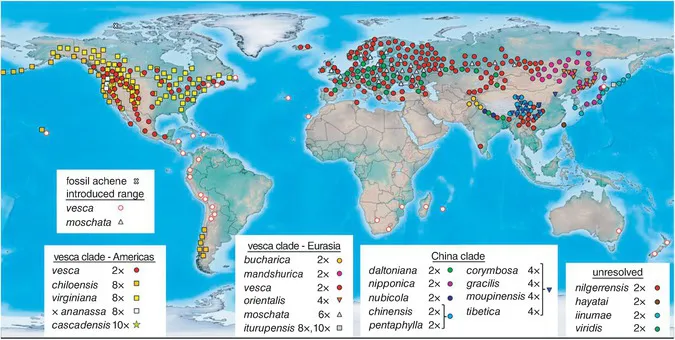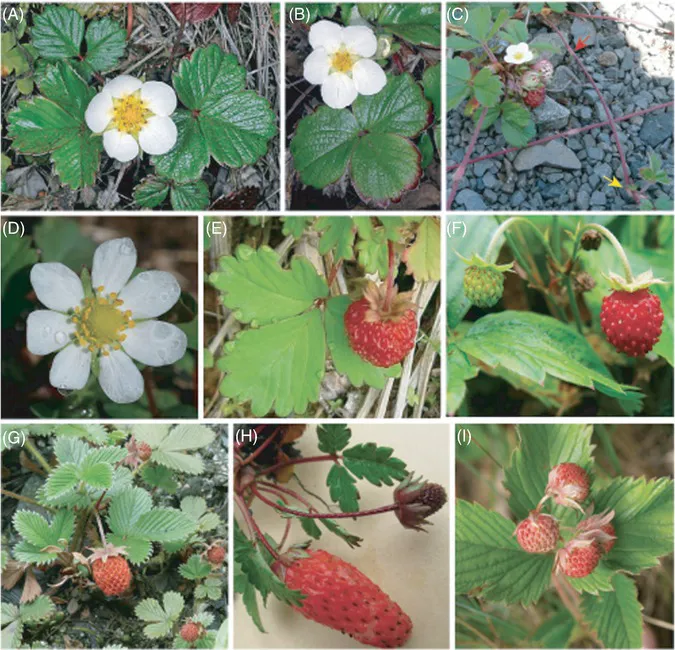![]()
1
STRAWBERRY SPECIES
INTRODUCTION TO SPECIES
Numerous species of strawberries are found in the temperate zones of the world. Only a few have contributed directly to the ancestry of the cultivated types, but all are an important component of our natural environment. The strawberry belongs to the family Rosaceae in the genus Fragaria. Its closest relatives are Duchesnea Smith and Potentilla L.
Species are found at six ploidy levels in Fragaria (Table 1.1; Fig. 1.1). The most widely distributed native species, Fragaria vesca, has 14 chromosomes and is considered to be a diploid. The most commonly cultivated strawberry, Fragaria × ananassa, is an octoploid with 56 chromosomes. Interploid crosses are often quite difficult, but species with the same ploidy level can often be successfully crossed. In fact, F. × ananassa is a hybrid of two New World species, Fragaria chiloensis (L.) Duch. and Fragaria virginiana Duch. (see below).
Table 1.1. Wild strawberries of the world and their fruiting characteristics. (Adapted from Staudt, 2008 and Liston et al., 2014.)
There are 13 diploid and 12 polyploid species of Fragaria now recognized (Table 1.1). Although a large number of the strawberry species are perfect flowered, several have separate genders. Some are dioecious and are composed of pistillate plants that produce no viable pollen and function only as females, and some are staminate male plants that produce no fruit and serve only as a source of pollen (Fig. 1.2). The perfect-flowered types vary in their out-crossing rates from self-incompatible to compatible (Table 1.1). Isozyme inheritance data have indicated that California F. vesca is predominantly a selfing species (Arulsekar and Bringhurst, 1981), although occasional females are found in European populations (Staudt, 1989; Irkaeva et al., 1993; Irkaeva and Ankudinova, 1994). Ahokas (1995) has identified at least two different self-incompatible genotypes of Fragaria viridis in Finland.
F. vesca has the largest native range of all the species, encompassing most of Europe, Asia and the Americas (Fig. 1.1). The rest of the species are more restricted in ecogeography, being clustered primarily in Euro-Siberia, northern China and Manchuria, Indo-South China, Japan and the Americas. Japan is particularly species rich, with at least four endemic species radiating across its islands. The cultivated strawberry F. × ananassa is grown in almost all arable zones of the world, although its native range is restricted to the Pacific Northwest of North America.
Varying degrees of reproductive isolation exist within and among ploidy levels (Bors and Sullivan, 2005; Nosrati et al., 2011a); however, several diploid and polyploid species of Fragaria grow sympatrically and produce interspecific hybrids. Hybrids of diploid F. vesca and F. viridis are found in Europe that have been named Fragaria × bifera (Staudt et al., 2003). Pentaploid hybrids have been found in California of F. vesca × F. chiloensis (Bringhurst and Senanayake, 1966) and in north-east China between Fragaria mandshurica × Fragaria orientalis (Lei et al., 2005). In Europe, both 5x and 7x individuals of F. vesca × Fragaria moschata have been reported (Nosrati et al., 2011b), as well as a single 9x individual of F. vesca × F. chiloensis in California (Bringhurst and Senanayake, 1966). A large zone of introgression exists in north-western North America between F. chiloensis and F. virginiana (Luby et al., 1992; Salamone et al., 2013).
INHERITANCE OF GENDER IN STRAWBERRIES
The genus Fragaria displays a number of sexual systems, including gynodioecy (females and hermaphrodites), subdioecy (females, males, and hermaphrodites), and dioecy (females and males) (Table 1.1). F. chiloensis is almost completely dioecious (Hancock and Bringhurst, 1980). F. virginiana populations commonly contain female, male and hermaphroditic individuals; a range in fertility can be found in hermaphrodites, from self-infertility to complete fruit set (Stahler et al., 1990, 1995; Luby and Stahler, 1993). Most commercial strawberries are now strict hermaphrodites, with sexual dimorphism having been bred out.
Ahmadi and Bringhurst (1991) originally suggested that sex in the octoploids was regulated at a single locus where female (F) is dominant to hermaphrodite (H), which is dominant to male (M). However, through genetic mapping Spigler et al. (2008, 2010) determined that the sex phenotype in octoploid strawberries is actually more complex and is determined by two linked loci, with sterility alleles at each. In their model, the male sterility allele (‘A’ for androecial function) is dominant to an allele conferring male fertility (‘a’), and at the female-function locus, a female fertility allele (‘G’ for gynoecia function) is dominant to an allele conferring female sterility (‘g’). F. chiloensis is almost completely dioecious (Hancock and Bringhurst, 1980) and sex determination is a classic ZW system in which males (staminant) are the homogametic sex (ZZ), while females (pistillate) are the heterogametic sex (ZW) (Charlesworth and Charlesworth, 1978; Tennessen et al., 2016). In the gynodioecious F. vesca ssp. bracteata, there are at least two unlinked loci carrying male sterility alleles, one being homozygous and the other heterozygous on chromosome IV (Tennessen et al., 2013; Ashman et al., 2015). In F. orientalis and F. moschata, Staudt (1967a,b) found tetrasomic inheritance for sex and he described the alleles for sex as male suppressor SuM (F) dominant to male inducer Su+ (H) and to the female suppressor SuF (M). SuF was dominant to Su+.
The sexual determining regions (SDR) of the octoploids have now been sequenced and mapped in four geographically distinct octoploid taxa: F. virginiana ssp. virginiana, F. virginiana ssp. platypetala, Fragaria cascadensis and F. chiloensis (Spigler et al., 2008, 2010, 2011; Goldberg et al., 2010; Tennessen et al., 2018). The SDR cassette contains two putatively functional sex-determining genes that moved at least three times by likely transposition, as evidenced by the size of their flanking sequence, which increased with each ‘jump’ (Tennessen et al., 2018). The SDR of F. virginiana ssp. virginiana, F. virginiana ssp. platypetala and F. chiloensis are found on a unique section of a chromosome from the same homoeologous group, but from a different subgenome. F. cascadensis male function maps to the same subgenome as in F. virginiana spp. platypetala but at a different chromosomal position (Wei et al., 2017b).
Tennessen et al. (2013, 2014) used targeted-sequence capture to map the sex determination regions in F. vesca ssp. bracteata. They identified locations affecting sexual phenotype on two chromosome regions, one on LG4 and another on LG6. The dominant allele (R) on LG6 appears to restore fertility in the absence of a male sterile allele at the LG4 locus. The F. vesca locus contains a high density of pentatricopeptid...



